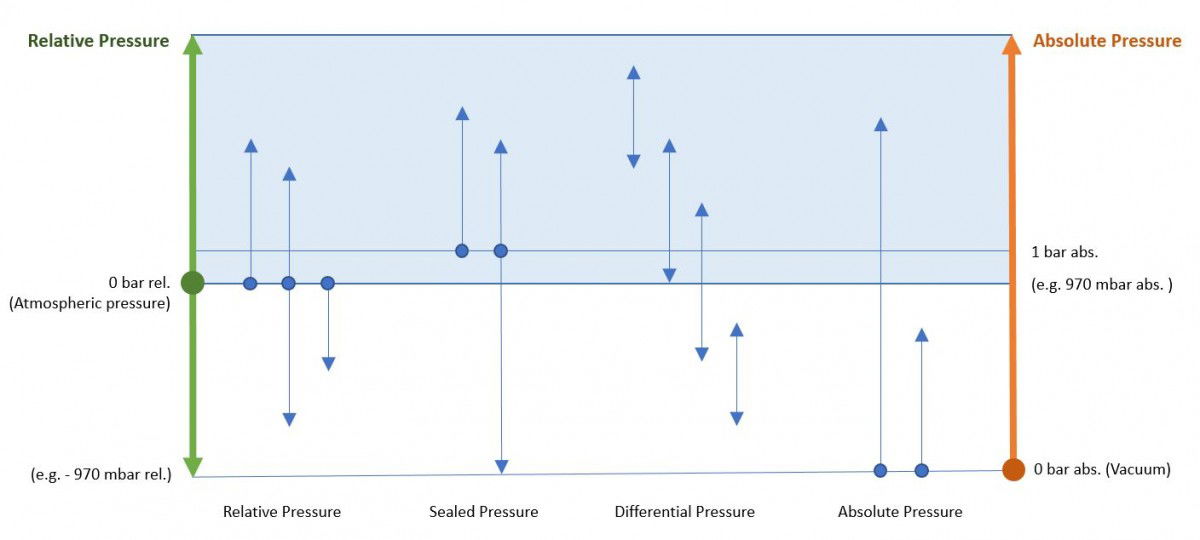Pressure Types and What They Mean
07. September 2021

Alongside temperature, pressure is one of the most important physical variables in modern-day technology. It is defined as a force acting perpendicularly upon a surface and its SI unit is the pascal. Other commonly used units are psi or bar.
In the world of pressure measurement technology, distinction is made between various pressure types, which differ from one another in terms of their reference point (reference pressure). Absolute pressure, relative pressure, sealed pressure and differential pressure are all pressure types. Piezoresistive pressure sensors by KELLER measure changes in pressure via the deformation of a membrane in the sensor element. This deformation is the result of the difference in pressure between the front process side of the membrane and the rear reference side. Depending on the type of pressure, the reference side is either open to the environment or sealed off from it.

Absolute pressure
With absolute pressure, process pressure is measured relative to a vacuum. During the manufacturing process, the rear reference side of the membrane inside the sensor element is exposed to a vacuum and sealed. If atmospheric pressure acts upon the membrane, the sensor measures the barometric atmospheric pressure. All fundamental physical formulae relating to pressure are based upon data in absolute pressure.
Pressure unit: bar abs.
Reference pressure: 0 bar abs. (vacuum)
KELLER designation: PAA (e.g. PAA-23SX)
Typical applications
• Barometers
• Vacuum packaging processes
• Vacuum pump monitoring
• Vapour pressure measurements
• Fill level measurements in sealed containers (with two sensors)
Relative pressure (overpressure)
With relative pressure, which is also known as overpressure, the process pressure to be determined is measured with reference to atmospheric pressure. In other words, the difference between the process pressure and the prevailing atmospheric pressure is determined. Atmospheric pressure is affected by both height above sea level and weather, and it is therefore subject to continual changes. Consequently, measurements that use relative pressure are well suited to processes that are affected by changes in atmospheric pressure. Relative pressure sensors always have a ventilation hole on the rear side of the measuring cell so that atmospheric pressure is present as a reference point for the sensor element inside the housing. Relative pressure is the most commonly used pressure type for pressure sensors and is to be found in almost all applications and branches of industry.
Pressure unit: bar rel.
Reference pressure: atmospheric pressure
KELLER designation: PR (e.g. PR-33X)
Typical applications
• Hydrostatic level measurements
• Pneumatic systems
• Air compressors
• Process control pumps
Sealed pressure
A special form of overpressure is sealed pressure, which combines the measuring principle of relative pressure with the benefits of a sealed sensor element. This pressure type is particularly useful in harsh working environments where ventilation of the measuring cell cannot be relied upon. Sealed pressure relates to a pre-defined reference pressure. For calibration purposes, KELLER typically refers to 1 bar abs. as the reference point. Since sealed pressure sensors are sealed off from the environment, they cannot compensate for atmospheric pressure changes. Depending on the application, the resultant measurement error is negligible or else additional measurement of atmospheric pressure must be made in order to compensate for this. KELLER uses absolute sensor elements for such overpressure sensors, as this prevents temperature changes having any increased impact on the sensor signal.
Pressure unit: bar
Reference pressure: 1 bar abs.
KELLER designation: PA (e.g. PA-23SY)
Typical applications
• Overpressure measurements in harsh environments where ventilation of the measuring cell is either not possible or not desirable.
• High-pressure applications: because the measurement error produced by changes in atmospheric pressure is negligible in relation to the accuracy of the pressure gauge.
• Hydrostatic level measurements where there is a risk of moisture or flooding in the area around the end of the cable.
Differential pressure
With differential pressure, the difference between two process pressures is measured. Gauges for measuring differential pressure therefore always have two process connections. Differential pressure measurements can either be performed with one individual sensor (bidirectional) or with two individual sensors whose signals are subtracted from one another. When there is just one sensor, the slightest differences in pressure can be measured, even when the line pressure (system pressure) is very high. With two sensors, not only can the differential pressure be measured, but the absolute line pressure can be determined too.
Pressure unit: bar diff.
Reference pressure: second process pressure
KELLER designation: PD (e.g. PD-39X)
Typical applications
• Filter monitoring
• Flow rate measurements
• Fill level measurements in sealed containers
Overview of pressure types





